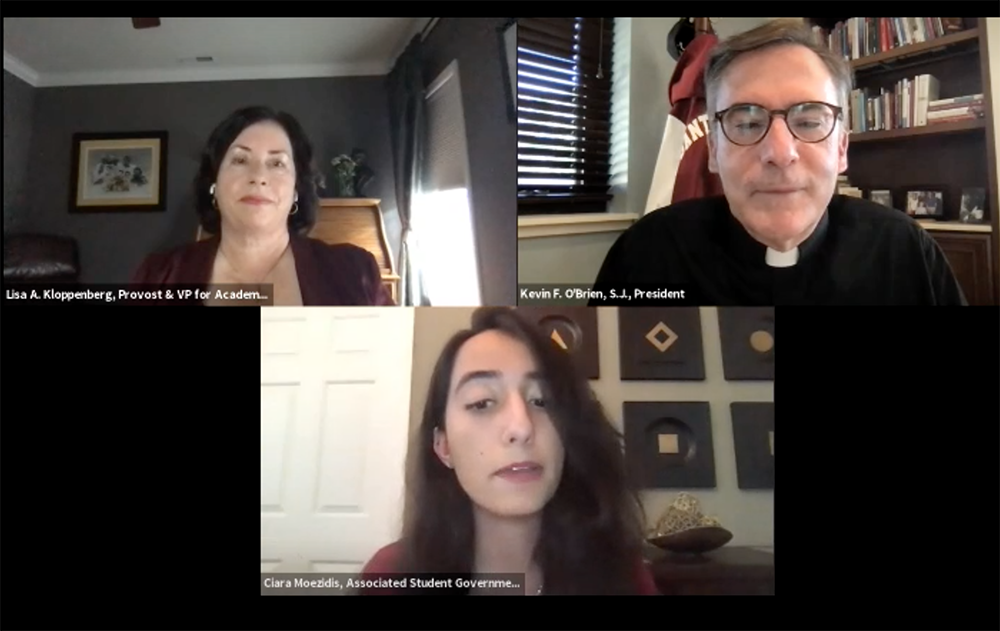
State of the University
As an undergrad at Santa Clara College over a century ago, Andrew Hill was an avid painter and photographer. He loved going to the old growth redwood forest in the Santa Cruz mountains. Learning that only about a quarter of the forest remained, he founded a club to protect the park from development. My predecessor, Fr. Robert Kenna, joined the fight and convinced the state to protect the land in 1902. To mark the campaign’s success, one of the oldest and largest trees was named after Santa Clara.
Late last summer, fire struck Big Basin, California’s oldest state park, and blackened most of its 18,000 acres. Despite widespread damage in the park, we learned in January that the Santa Clara tree survives, standing 240 feet tall, and 20 feet in circumference. Redwoods, like the Santa Clara tree, are a resilient species, because their thick bark provides great protection. While damaged at the base, the winter rains are likely to yield shoots of green on the tree. No wonder the coastal redwoods are called, Sequoia Sempervirens, which means “ever-living Sequoia.”
I’ve thought a lot about our redwood in Big Basin these last few months. Much like our beloved university, the majestic tree is a model of resilience and adaptation. Individually and as a community, we have dealt with impacts from the COVID pandemic, and have reckoned again with the pandemics of racism, income inequality, and environmental degradation. The pandemics have scarred us in so many ways, individually and communally.
And yet, Santa Clara’s mission is sempervirens, ever-living. We stand tall, though admittedly a bit worn and weary. Because of you – our students, faculty, and staff – our mission of teaching, learning, research, and service continues, though in different form. Our alumni and benefactors have stood by us and supported us in many ways. Not since World War II have the operations of our university been so disrupted. And yet, a year after the beginning of the pandemic, shoots of spring and seeds of hope emerge. The disruptions have been jarring and painful at times, but they have also revealed a latent strength, creativity, and colleagueship that we might not have otherwise noticed.
So before diving into the details of the State of our University, I want to offer you a word of hope. This hope is not naïve optimism or a flight of fancy, which easily explains away or glosses over hurts and losses. To the contrary, this hope is firmly grounded in reality, even painful realities, and yet hope insists that pain and loss have meaning, and they can strengthen us for the journey ahead.
The words of Amanda Gorman, the youth poet laureate, at last month’s inauguration linger in the air as if to console and challenge us here:
“That even as we grieved, we grew
That even as we hurt, we hoped
That even as we tired, we tried
That we'll forever be tied together, victorious
Not because we will never again know defeat
but because we will never again sow division.”
Hope lifts our gaze to a horizon not of our own making. In this very long year of separation, we realize how much we miss one another’s company, which we may have taken for granted. Because of what we learned this year in the crucible of the pandemic, we are becoming better educators. We will also be better people and citizens because of our common commitment to advance racial justice and secure more equitable health and economic conditions for all, even when the conversations are hard and the struggles arduous.
Hope is fuel for the journey, and the wind at our backs. Sometimes hope comes easy. Other times, when the journey gets hard and we are tempted to give up, we must choose to hope in face of fear, fatigue, or despair. The hope we choose is contagious, a gift from God that we can offer to another at just the right time to encourage them. We must never forget to care for one another and be generous as we approach hope’s horizon.
People who choose hope live, teach, love, and serve differently. They become heralds of the dawn we all yearn for.
The trees in Big Basin are awesome, beautiful to behold in their ever-living majesty. But even more inspiring to me are the people who gaze upon them, the people after whom that one big, resilient tree is named: the people at Santa Clara. Thank you for your company on this most remarkable journey since I offered the State of the University last year. The State of the University this year may well have been unexpected a year ago but it is as strong as ever because of you.
May God bless us on the journey.